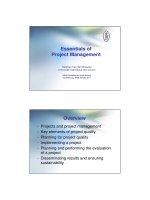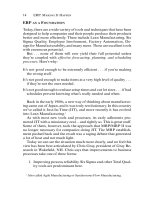The Essentials of Project Management potx
Bạn đang xem bản rút gọn của tài liệu. Xem và tải ngay bản đầy đủ của tài liệu tại đây (296.5 KB, 13 trang )
The Essentials of
Project Management
Third Edition
DENNIS LOCK
1
Introduction to Project
Management
All projects share one common characteristic – the projection of ideas and activities
into new endeavours. The ever-present element of risk and uncertainty means that
the events and tasks leading to completion can never be accurately foretold. Examples
abound of projects that have exceeded their costs by enormous amounts, nishing
late or even being abandoned before completion. Such failures are far too common
and are seen in all kinds of projects in industry, commerce and the public sector.
The purpose of project management is to predict as many of the dangers and
problems as possible and to plan, organize and control activities so that projects are
completed successfully in spite of all the risks. This process should start before any
resource is committed and must continue until all work is nished. The primary aim of
the project manager is for the result to satisfy the project sponsor or purchaser and all
the other principal stakeholders within the promised timescale and without using more
money and other resources than those that were originally set aside or budgeted.
DIFFERENT TYPES OF PROJECTS
The principal characteristic of a project is its novelty. It is a step into the unknown,
fraught with risk and uncertainty. No two projects are ever exactly alike: even
a repeated project will differ from its predecessor in one or more commercial,
administrative or physical aspects. However, I nd it convenient to identify four
different types of projects.
Type 1 projects: civil engineering, construction,
petrochemical, mining and quarrying
Projects in this category spring to mind whenever industrial projects are mentioned.
One common feature is that work must be conducted on a site that is exposed to
the elements and usually remote from the contractor’s head ofce. These projects
are thus open to public gaze. They incur special risks and problems of organization.
They may require massive capital investment and they deserve rigorous management
of progress, nance and quality. Operations are often hazardous so that health
ess entials of pro ject man age ment
2
and safety aspects demand special attention, particularly in work such as heavy
construction, tunnelling and mining.
For very large industrial projects the funding and resources needed can be too
great for one contractor to risk or even nd. The organization and communications
are therefore likely to be complicated by the participation of many different
specialists and contractors, possibly with the main players acting together through
a consortium or joint venture company established specically for the project.
Type 2 projects: manufacturing
Manufacturing projects result in a piece of mechanical or electronic equipment,
a machine, ship, aircraft, land vehicle or some other product or item of specially
designed hardware. The nished product might be purpose-built for a single
customer but internal research and development projects for products to be sold in
all market sectors also fall into this manufacturing category. Manufacturing projects
are usually conducted in a laboratory, factory or other home-based environment
where the company should be able to exercise on-the-spot management and provide
an optimum environment in which to do and manage the work. Of course, these
ideal conditions do not always apply. Some manufacturing projects involve work
away from the home base, for example in installing and commissioning a machine
or equipment on a customer’s premises, customer training and post-project service
and maintenance.
More difcult is the case of a complex product that is developed and
manufactured by a consortium of companies, sometimes with members based in
different countries. An example is aircraft production, where the engines might
be developed and manufactured in one country, the wings in another and the
nal assembly taking place in a third country. Such international manufacturing
projects are prone to higher risk and difculties in control and coordination arising
through organizational complexity, national rivalries, contracts, long-distance
communications, multiple languages and conicting technical standards.
Type 3 projects: IT projects and projects associated with
management change
This class of project proves the point that every company, whatever its size, can
expect to need project management expertise at least once in its lifetime. These
are the projects that arise when companies relocate their headquarters, develop
and introduce a new computer system, launch a marketing campaign, prepare
for a trade exhibition, produce a feasibility or other study report, restructure the
organization, mount a stage show, or generally engage in any operation that
involves the management and coordination of activities to produce an end result
that is not identiable principally as an item of hardware or construction.
Most not-for-prot organizations, including national and local government
departments, professional associations, charities and disaster relief agencies,
conduct projects that fall into this category of management projects.
int roductio n
3
Although management projects do not usually result in a visible and tangible
creation such as a piece of hardware, much often depends on their successful
outcome and they can require enormous investment. There are several well-known
cases where, for instance, failure to implement a new computer system correctly
has caused serious operational breakdown exposing the managers responsible to
public discredit. Effective project management is at least as important for these
projects as it is for the largest construction or manufacturing project.
Type 3 projects may be associated with, or even depend upon, Type 1 or Type 2
projects. For example, if a company decides to relocate to a new purpose-built ofce,
the overall relocation project is itself a Type 3 management project but its success
will depend also on the Type 1 project needed to construct the new building. Thus
projects of different types may be associated with each other in a company’s project
programme or project portfolio.
Type 4 projects: projects for pure scientic research
Pure scientic research projects (not to be confused with research and development
projects) are a special case. They occasionally result in dramatically protable
discoveries. Conversely, they can consume vast amounts of money over many
years yet yield no practical or economic result. Research projects carry the highest
risk because they attempt to extend the boundaries of human knowledge. The
project objectives are usually difcult or impossible to dene and there may be no
awareness of the possible outcome. Therefore, pure research projects are not usually
amenable to the project management methods that can be applied to industrial,
manufacturing or management projects.
Some form of control over pure research projects must, however, be attempted.
Money and other resources cannot be spent without any form of monitoring or
restraint. Budgets have to be set in line with available funding. A sensible method
for controlling a pure scientic research project is to conduct regular management
reviews and reassessments of the potential value of the project. At each review, a
decision can be taken stop the project (known colloquially as ‘pulling the plug’) or
release new funding to allow it to continue at least until the next review. Although
this can be unsettling for the scientists involved, the project sponsor is not expected
to pour money forever into a vast hole. This procedure, where continued project
funding is dependent upon regular reviews, is known as stage-gate control.
Although the research activities might themselves lie outside the scope of familiar
project management methods, the provision of accommodation, communications,
equipment and research materials can constitute Type 1, 2 or 3 capital investment
projects to which proper project management can and must be applied.
PROJECT LIFE CYCLES AND LIFE HISTORIES
Most authorities and writers, when they talk about the life cycle of a project, refer to
the period that begins with the authorization of work on the project (or signing of
ess entials of pro ject man age ment
4
a customer-contractor contract) and ends with the handover of the desired product
to the customer. Although that view can be too simplistic, it is the part of projects
that is of most concern to project managers (and which is covered in this book).
Figure 1.1 shows that the activities which take place during this period form a true
cycle because they begin and end with the customer.
Travelling clockwise round the cycle reveals a number of steps or phases. In
practice, these phases often overlap each other so that the boundaries between
them are blurred. For example, some project purchasing and fullment work can
usually start well before the design phase is complete.
The view of a project life cycle shown in Figure 1.1 is too simplistic for most
projects because it ignores everything that happens before the start of actual
work and takes no account of what happens to the project after its delivery to the
customer. For a more complete picture we have to consider not only the project life
cycle as seen by the project manager but also the entire life history of the project
from its initial conception to nal death and disposal. Figure 1.2 shows this more
complete view of a project life history.
Many writers limit their account of the project life cycle or life history to phases
six to 13 because these are the phases that usually come under the control of the
project manager. They constitute the most active period of the project life history
(sometimes called the fullment period). This period corresponds in most respects
to the life cycle in Figure 1.1. The chapters in this book are arranged as far as
possible in this life cycle sequence.
Figure 1.1 The active part of a project life cycle
int roductio n
5
FACTORS FOR ASSESSING PROJECT SUCCESS OR
FAILURE
The success of the contractor and the project manager will usually be judged
according to how well they achieve the three primary objectives, which are:
Project completion within the cost budget;
the project delivered or handed over to the customer on time;
good performance, which requires that all aspects of the project are nished in
accordance with the customer’s project specication.
Factors necessary for achieving these three objectives include the following:
Good project denition and a sound business case;
appropriate choice of project strategy;
strong support for the project and its manager from higher management;
availability of sufcient funds and other resources;
rm control of changes to the authorized project;
technical competence;
a sound quality culture throughout the organization;
a suitable organization structure;
appropriate regard for the health and safety of everyone connected with the
project;
good project communications;
1.
2.
3.
•
•
•
•
•
•
•
•
•
•
Figure 1.2 The project life cycle (life history) of a larger project
ess entials of pro ject man age ment
6
well motivated staff;
quick and fair resolution of conict.
These issues are all important for good project management.
An apt denition of a successful project is that it should satisfy all the
stakeholders. This is an ideal that might be difcult to achieve because stakeholders
often view a project from different perspectives but it is a worthwhile goal.
RELATIONSHIP BETWEEN THE THREE PRIMARY
OBJECTIVES
It is occasionally necessary to identify one of the three primary objectives as being
of special importance. This emphasis can affect the priority given to the allocation
of scarce resources and the way in which management attention is concentrated.
It can also inuence the choice of project organization structure (discussed in
Chapter 5).
A management decision to place greater emphasis on achieving one or two
of these objectives must sometimes be made at the expense of the remaining
objectives. The outcome of such a trade-off decision can be indicated by placing
a spot or blob within a triangle which has one primary objective placed at each of
its corners (shown in Figure 1.3). For example, if cost is the greatest consideration,
the blob will be placed in the cost corner. If all the objectives are regarded as equal
(balanced), the blob will be put in the middle of the triangle.
A project for a charitable organization with limited funds would have to be
controlled very much with budgets in mind so that costs must be the project
manager’s chief concern. Industries such as aerospace and nuclear power generation
have to place high emphasis on safety and reliability so performance should be the
most important objective. A project to set-up and stock a stand at a trade exhibition,
for which the date has been announced and the venue booked, is so dependent on
meeting the time objective that it might be necessary to overspend on budgets to
avoid missing the date.
The quality/cost relationship
It is a mistake to believe that there can be a simple and acceptable trade-off between
quality and cost. Those who promote total quality management argue, correctly,
that quality can be achieved without extra cost. However, there is an even more
fundamental reason why quality can not be downgraded or compromised to save
money. This becomes clear when we accept the denition of quality as a service
or product that is ‘t for the purpose for which it was intended’. No contractor
or project manager should ever contemplate a result that is not ‘t for purpose’.
Therefore downgrading quality is not an option. That is why performance or
level of specication is placed at the corner of the triangle of objectives rather
than quality.
•
•
int roductio n
7
This distinction between quality and specication is illustrated by the following
example. Suppose that the initial estimates for a new building are too high and that
construction costs must be reduced. One option might be to build on relatively simple
foundations instead of using deep sunk piles, which could save thousands of pounds.
But if the ground conditions demand piling for the building to be safe, that cost-saving
option is ruled out on the grounds of reliability and safety. It would compromise quality
and is not a viable option. The building would not be t for its intended purpose.
However, suppose that the same developer reviews the specication for interior
nishes and nds that marble oors could be replaced with carpeted oors at a
substantial cost saving. The oors would still be serviceable and t for purpose.
Carpeting would, therefore, be an option that would not compromise quality.
Quality has not been changed but the specication has.
The time/cost relationship
TIME IS MONEY!
(Benjamin Franklin, in Advice to a Young Tradesman, 1748).
There is usually a direct and very important relationship between time and money.
If the planned timescale is exceeded, the original cost estimates are almost certain
to be overspent. A project costs money during every day of its existence, working or
non-working, weekday or weekend, from day one of the programme right through
until the last payment has exchanged hands. These costs arise for a variety of
reasons, some of which will now be explained.
The effect of project delays on direct costs
The variable or direct costs of labour and materials are time-related in several ways.
Cost ination is one factor, so that a job started and nished later than planned
Figure 1.3 The triangle of objectives
ess entials of pro ject man age ment
8
might cost more that the original estimate because of price rises in materials and
increases in wages, salaries and other costs.
There are other less obvious causes where late working implies inefcient working,
perhaps through lost time or waiting time (often the result of materials shortages,
missing information or poor planning, communications and organization). If any
project task takes longer to perform than its planned duration, it is probable that
the budgeted man-hours will be exceeded. This is true not only for a single task but
also for the project as a whole.
The effect of project delays on indirect (overhead) costs
The xed or overhead costs of management, administration, accommodation,
services and general facilities will be incurred day by day, every day, regardless of
work done, until the project is nished. If the project runs late these costs will have
to be borne for a longer period than planned. They will then exceed their budget.
The effect of project delays on the costs of nancing
Another important time-related cost is nancing. Where the contractor has an
overdraft at the bank or relies on other loan nancing, interest has to be paid on the
loan. Even if the contractor nances the project from available funds there is still a
notional cost of nancing equivalent to the interest or dividends that the same funds
could have earned had the contractor invested the money elsewhere (such as in a
bank deposit account). If a project runs late, the nancing period is extended and the
amount of interest or notional interest payable must increase correspondingly.
Much of the money for a large project is likely to be invested in work in progress
as the project proceeds. This work in progress includes not only the tangible results of
a project, such as construction or manufacture, but also intangible elements such as
planning and engineering or design. In many projects the contractor can only charge
the customer for work that can be certied as nished. For example, in construction
projects the amount of work completed usually has to be inspected and certied by
an independent quality surveyor or engineer before it can be billed to the customer.
The customer will not pay without the receipt of certied invoices to show that the
work claimed has been done. Certied invoices are often linked to planned events or
milestones. If a milestone has not been reached, a certied invoice cannot be issued.
Payment of the contractor’s revenue is then delayed which means that the contractor
must continue to nance the mounting costs of the project. The contractor could
then suffer severe cash ow problems and even nancial ruin.
Cost penalties
Some contracts contain a penalty clause which provides the customer with the
sanction of a cost penalty against the contractor for each day or week by which the
contractor fails to meet the contracted delivery obligation.
int roductio n
9
The total cost effect of project delays
All these time/cost considerations mean that delays on a project can easily cause
additional costs amounting to thousands of pounds per day. It is clear that if work
can be managed so that it proceeds without disruption against a sensible and
achievable plan, much of the battle to control costs will have been won.
PERCEPTIONS OF PROJECT SUCCESS OR FAILURE
BEYOND THE THREE PRIMARY OBJECTIVES
Most project managers are expected to complete their projects so that they satisfy
the three primary objectives of time, performance and cost. These are usually the
most important factors that drive the project contractor and they should align
with the foremost expectations of the project owner. Most project management
procedures (and this book) are directed towards achieving these goals which could
be summarized as delighting the customer while creating a commercial success for
the contractor. In this context the contracting organization and the customer are
both primary stakeholders in the project.
However, most projects have to satisfy more than two primary stakeholders.
For example, a bank that has provided loan nance for a project will have a keen
interest in whether the project succeeds or fails. There will always be people and
organizations who, while not being principal stakeholders, nonetheless have an
interest in how the outcome of a project might affect them. Subcontractors and
suppliers are an example. Staff working on a project have a stake in the outcome
because project success or failure can (apart from contributing to job satisfaction)
have implications for their future employment and careers.
Identifying and ranking the stakeholders
Stakeholders are the people and organizations who affect, or will be affected by, the
project. The principal stakeholders in most projects are as follows:
The customer or client;
the contractor that must perform all the project tasks, either directly or through
suppliers and sub-contractors;
the investor – for small projects the customer might be able to nance the
project without external help but larger projects often need nancing support
from one or more banks or from other sources such as shareholders.
In management projects and all other projects carried out internally within a
company or group of companies, the company is the customer or client and the
internal department principally responsible for carrying out the work is effectively
the contractor.
1.
2.
3.
ess entials of pro ject man age ment
10
In some projects the initial customer purchases the project with the intention
of selling it on to a third party. A common example is the property developer who
commissions a new building from a contractor with the intention of selling it on
(or leasing it) to occupiers. In that case the occupiers are sometimes known as
the project end-users. Another example would be a customer that orders a batch
of specially manufactured goods for selling on to retail customers. Those retail
customers would also be end-users.
The range and nature of stakeholders will vary greatly from one project
to another but the principle of stakeholder identication can be illustrated by
an example. Suppose that a project has been proposed to redevelop a derelict
urban area. This project will provide a shopping mall, ofces, cinema and other
leisure facilities, new roads and so on. The primary stakeholders for this project
will certainly include the main project contractor and the project owner. The
banks or other organizations nancing the project will also have a considerable
primary interest in the project’s success or failure. Not least of the stakeholders
are those who hold shares or have otherwise invested in participating companies
that, by accepting an element of risk, stand to make a prot or loss from the
project.
Sub-contractors, suppliers, staff, artisans and labourers can all be considered
stakeholders although these could be placed in the second rank. Intended occupiers
of the shops, ofces and other premises also have a stake in the project.
There are others who will be dependent on the secondary stakeholders. These
are the wholesale suppliers of merchandise to be sold in the new shops, service
staff such as car park attendants, shop and ofce workers, companies expecting to
provide security, cleaning and maintenance services and so on.
Public transport organizations must consider how the development will
affect their passenger numbers: some of their existing services might need to be
changed to suit the new travel patterns (and take advantage of the new business
generated).
Then there are the various regulatory authorities such as the local building
inspectors, planning ofce and many other ofcial organizations. These are all
stakeholders whose decisions and actions can affect the project.
People living near the proposed development will benet from the new
shopping and leisure facilities but might resent the inconvenience of construction
works and the prospect of increased trafc and noise when the new premises start
to function. Parents might be concerned that their schoolchildren will have to
cross streets that are busier and more hazardous. Motorists and other road users
will be interested in how the new road layouts will affect their journeys. The new
entertainments facilities will provide wider opportunities for live artistes.
This discussion could be carried on at length to identify still more stakeholders.
Some will have power to inuence the project while others will be able only to
voice opinions. All stakeholders might be ranked (primary, secondary, tertiary and
so on) according to the power that they can wield and the impact that the project
will have on them.
int roductio n
11
BENEFITS REALIZATION
In most industrial and manufacturing projects the project owner should start to
realize the expected benets immediately or shortly after the project is successfully
nished and handed over (Phase 13 in Figure 1.2). A chemical plant, once
successfully commissioned, should be capable of producing saleable product. A
successful new ofce building should provide a pleasant working environment
that can immediately improve staff satisfaction (and thus productivity). However,
business change and IT projects can be different because their most signicant
benets tend to be realized much later in the project life history, during the rst
months (or even years) of the period shown as Phase 14 in Figure 1.2.
Consider, for example, a large-scale project that is intended to replace and
standardize the customer service and invoicing systems of all the companies in
an international group. The execution phase of the project is nished when the
IT designers have developed, documented and tested the software. If the IT was
contracted out, the IT specialist contractor might have had a successful project
outcome with all three primary objectives of cost, performance and time satised
at the time of hand over to the user company. However, there is much more to
the success of a management change project than the technical excellence and
performance of the IT. It is only when the new system is up, running and accepted
by the managers and staff of all the companies in the group that the project
owner can begin to regard the project as a success. Implementing new systems
and procedures can be very difcult in any organization where the staff resist
change, have understandable concerns about possible redundancies, come from
a rich mixture of different cultures or resent having to cope with all the teething
problems that signicant changes create.
In recent years these difculties have led to new ways of assessing and managing
the benets realization of management change and IT projects. It is now recognized
that the benets realization process should start during early project denition by
establishing benchmarks that can be put into place in the business plan. These
benchmarks have some similarity with the milestones set in the project execution
plans of all projects but for management change and IT projects there are two
important differences:
The most important benchmarks often occur some time after initial handover
and commissioning of the project from the contractor to the customer
(remembering that the contractor and owner can be in the same company).
Each benchmark must be directly associated with a cash inow, cost saving or
other real benet that can be tracked to a favourable entry in the company’s
accounts or management reports.
Benets realization is appreciated among the more enlightened management
fraternity as the most important driver in a management change or IT project so
that the intended long-term benets are kept in the minds of the project manager
and the other project stakeholders.
1.
2.
ess entials of pro ject man age ment
12
There is no reason why some of these new and specialized benets realization
management processes should not be applied or adapted for use in industrial and
management projects.
ORGANIZATIONS REPRESENTING THE
PROFESSION OF PROJECT MANAGEMENT
The International Association of Project Management (IPMA)
The profession of project management is represented by the International
Association of Project Management (IPMA) which is European based but has
branches internationally. The UK corporate member is the Association for Project
Management (APM) with the following headquarters address:
The Association for Project Management
150 West Wycombe Road
High Wycombe
Buckinghamshire
HP12 3AE
Telephone: 0845 458 1944
Email:
Website: www.apm.org.uk
The Project Management Institute (PMI)
Based in the US, the PMI is the world’s largest project management association,
with branches (which they call chapters) in many countries. For more information,
contact PMI at:
PMI Headquarters
Four Campus Boulevard
Newtown Square
PA 19073-3299
USA
Telephone: +610-356-4600
Email:
Website: www.pmi.org









